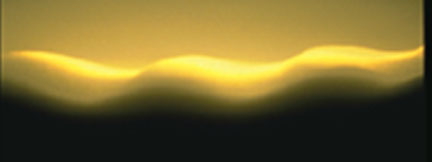
Spring Box mimics the turbulent emergence of spring water in a sandy bottomed pool. Visitors can change the flow of water which is pumped through a column of sand, thereby controlling a burbling head of sand and water.Dimensions: 40" x 68" x 38" Weight: 450 lbs.
Artists Statement:
In late February, 1996, I began work on the Spring Box prototype. I had spent several hours interviewing Ned Kahn and Jim Crutchfield (from the Santa Fe Institute and Cal) for an upcoming show called Turbulent Landscapes. As a staff developer, I couldn't resist trying some ideas out after listening to these two talk about complexity theories for hours.
Growing up in California, I have spent most of my summers at a family ranch in eastern Nevada, near Ely. Over the years, those summers became important to me and, in many ways, defined who I was and how I viewed the world. I first saw the phenomenon of Spring Box when I was very young. It bubbled up in a small spring pond, just below the ranch.
The pond was only two feet deep, maybe thirty yards long and ten yards at its widest. At the top of the pond, a whole series of bubbling springs came through the flat, sandy bottom. Over the years they changed their location and intensity, but I remember floating over them in an innertube, looking down and wondering where the hell all the water was coming from.
I didn't remember exactly what it looked like, but I remembered how it behaved. So I began prototyping by pouring some glass beads in a large glass tube I found in the rotunda. Pumping water through the sand created a small, unstable "head" of sand and spurting water. Sometimes it moved and swayed in a cyclical rhythm, other times it leaned sideways and scooted across the tube. It had quite a personality and Ned strongly encouraged me to pursue the project.
Pete Richards (who curated the show) came and looked at the piece, nodded and smiled a bit and Spring Box was given the go ahead for the show. Melissa somehow managed to find the extra funds needed for the piece and Jim Meader OK'd the work time. I was given three weeks to complete the project.
I designed the case to resemble what I called a "Spring Box." Ranchers often cover their springs with rough, durable wooden or concrete boxes to keep cattle from clogging and muddying the spring. These boxes are covered with a heavy wood or tin lid so that the spring can be cleared and looked after.
Moss-covered and whitened by exposure, the water makes these boxes a center for plants, bugs, and all sorts of small animals. There is a rare merger of nature and human construction at spring boxes; they remain functional, but they have become part of the natural terrain.
